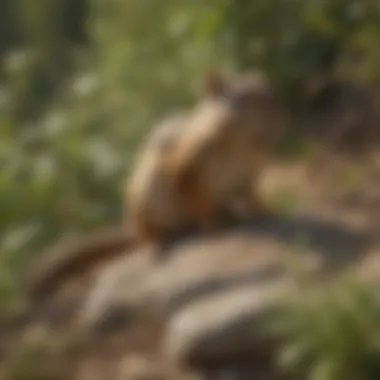Natural Ways to Deter Chipmunks in Your Garden


Intro
Chipmunks can be a delightful sight in gardens and backyards. However, their nibbling on plants and seeds can quickly turn from charming to problematic. For homeowners and gardeners seeking to protect their plants without harming the environment, understanding how to deter these small mammals naturally is crucial. This guide compiles effective and eco-friendly strategies that underscore the behavioral traits of chipmunks and how these can be leveraged in pest management.
Understanding Pests
Definition of Pests
In a broad sense, pests are organisms that cause harm to crops, animals, humans, or any desirable vegetation. They can vary from insects to mammals like chipmunks. Understanding what defines a pest is the first step in learning to combat them effectively.
Importance of Pest Identification
Identifying a pest accurately is essential. Chipmunks, for example, are often confused with other small mammals. Knowing their habits can help homeowners design targeted deterrent strategies. Chipmunks are partially diurnal, foraging both in the morning and late afternoon, which makes them more active at certain times of day. This unique behavioral understanding enables the use of effective deterrents strategically.
Prevention Techniques
Home and Garden Preventative Measures
Preventing chipmunks from entering gardens is often more practical than trying to remove them once they take residence. Here are several useful techniques:
- Barrier Creation: Installing fencing can block chipmunk entry. The fence should be at least three feet tall and buried a foot under the ground to prevent digging.
- Natural Barriers: Certain plants, such as mint or marigolds, can act as repellents, naturally dissuading chipmunks from venturing into specific areas of the garden.
Seasonal Prevention Tips
Seasonal changes can influence chipmunk behavior. During warmer months, they are more active. Therefore, monitoring your garden more closely during spring and summer will help.
- Spring Preparation: Before planting, consider applying a layer of gravel or wood chips around key planting areas. This can disrupt chipmunk pathways.
- Fall Cleanup: Ensure that fallen nuts, seeds, and fruits are removed in the fall. This reduces food sources that attract chipmunks looking for winter stores.
Eco-Friendly Pest Control Solutions
Overview of Sustainable Practices
Eco-friendly pest control emphasizes harmony with nature rather than chemical intervention. Sustainable practices can incorporate various techniques that align with a healthy ecosystem preference.
- Companion Planting: This involves planting species that naturally repel chipmunks in proximity to vegetation that you wish to protect.
- Habitat Modification: This means altering the environment around your home to make it less conducive to rodent habitation. Removing clutter and debris can reduce places where chipmunks nest.
Natural Remedies and Their Effectiveness
Various natural remedies can deter chipmunks effectively. Some methods include:
- Cayenne Pepper or Cinnamon: Sprinkling these spices around plants may create an unpleasant taste or odor for chipmunks, steering them away from gardens.
- Fabric Softener Sheets: Some gardeners report success using these sheets around the garden, as the scent deters small mammals.
"Understanding the behavior and habits of chipmunks is key for effective natural deterrence strategies."
Exploring these techniques provides a multifaceted approach to managing chipmunk populations naturally, preserving ecological balance while safeguarding your garden’s health.
Understanding Chipmunks
Understanding chipmunks is a crucial first step for homeowners and gardeners aiming to manage these small mammals effectively. These creatures can impact gardens, landscapes, and the overall environment in significant ways. By gaining insight into their behavior and habitats, individuals can implement targeted strategies for keeping them at bay.
Anatomy and Behavior of Chipmunks
Chipmunks have distinctive physical features that make them easily recognizable. They are small rodents, falling under the family Sciuridae, with a slender body, prominent cheek pouches, and a striped coat. Typically, they measure around 8 to 10 inches in length, including their tail.
Their cheek pouches are essential for gathering food and transporting it back to their burrows. Understanding these anatomical traits helps in knowing how chipmunks forage. Chipmunks are mostly nocturnal, exhibiting activity peaks during dawn and dusk. They often scavenge for seeds, nuts, and even insects, which plays a role in their behavior.
Their natural instinct is to hoard food. This behavior can lead to problems for garden enthusiasts, as they tend to dig up planted seeds and tubers. Chipmunks are territorial and have a defined home range, usually consisting of a singular burrow system. Sharing space can lead to aggressive behavior, which may affect how they interact with their environment, impacting other small wildlife and human landscaping efforts.
Common Habitats and Range
Chipmunks primarily inhabit wooded areas, gardens, and suburban regions across North America. Their range covers Eastern and Western parts of the continent, adapting well to environments that offer ample cover and food sources. They create elaborate burrow systems, which serve multiple purposes, such as nesting and food storage, often hidden under trees' roots or within rock piles.
In gardens, they thrive in areas that facilitate their foraging instincts, making flowerbeds and vegetable patches prime targets. Chipmunks prefer locations with ground cover or shrubs, providing necessary concealment from predators. By assessing your surroundings and understanding where chipmunks are likely to reside, it becomes easier to implement deterrence strategies.
"The key to managing a chipmunk problem lies in understanding their behavior and habitats. Knowing what attracts them can help prevent potential issues before they start."
Comprehensively grasping chipmunk anatomy and habitats helps homeowners and gardeners devise proactive measures, creating a balanced approach to natural deterrence.
Why Deter Chipmunks?
Detering chipmunks is essential for homeowners and gardeners for several significant reasons. These small rodents, while often perceived as charming creatures, can cause a variety of problems in residential areas. Their presence might seem benign at first, but understanding the implications they bring can highlight the necessity of effective deterrence strategies.
Impact on Gardens and Landscapes
Chipmunks are notorious for raiding gardens. They dig up bulbs, consume tender plants, and hoard seeds. Additionally, these animals may eat fruits and vegetables before they even ripen. The damage can escalate quickly, impacting both the aesthetics and productivity of garden spaces. For instance, a flourishing vegetable garden can turn into a patch of gnawed remains if appropriate actions are not taken.
Moreover, certain plants are susceptible to extensive digging. Chipmunks often create burrows, creating unsightly holes in well-kept landscapes. This leads to increased maintenance costs as homeowners may need to restore a landscape's integrity.
Strategies to deter chipmunks protect valuable garden investments and preserve the beauty of outdoor spaces. Implementing these strategies prevents damage and loss.


Health Concerns and Property Damage
In addition to their environmental impact, chipmunks pose health risks and can contribute to property damage. As carriers of various diseases, chipmunks can transfer pathogens through their droppings, urine, and bites. These are not just pest problems; they can lead to significant health concerns for families and pets.
Furthermore, their burrowing behavior can compromise the structural integrity of properties. Undermined foundations or pathways result from extensive tunneling. This could lead to costly repairs and make homes more susceptible to water damage during heavy rains.
Addressing chipmunk issues is about more than just aesthetics. It encompasses safeguarding health and protecting property. Awareness of these factors makes clear the importance of setting up natural deterrence methods.
Behavioral Insights for Natural Deterrence
Understanding the behavior of chipmunks is crucial for anyone attempting to deter them naturally. Chipmunks exhibit specific feeding and territorial patterns, which can be strategically used to their disadvantage. By leveraging these behavioral traits, homeowners and gardeners can develop effective deterrent measures that do not harm these creatures but simply encourage them to seek refuge elsewhere.
Utilizing Chipmunk Feeding Patterns
Chipmunks display distinct feeding habits that can inform deterrence strategies. They are most active during twilight hours, primarily focusing on foraging for seeds, nuts, and fruits. Observing their feeding patterns can help identify when and where they are most likely to invade gardens or yards. Homeowners can take several steps to minimize interactions:
- Timing of Planting: Align planting schedules with times when chipmunks are less active, possibly at noon or late evening.
- Plant Choices: Select plants that are less appealing to chipmunks. For example, plants such as daffodils are toxic to them and can act as a natural repellent.
- Food Sources: Secure any bird feeders and clean up fallen fruits or nuts. This reduces available food, making the area less attractive.
Utilizing their feeding patterns not only helps in making your garden less appealing but also creates an environment that encourages chipmunks to seek sustenance elsewhere.
Exploiting Territorial Behavior
Chipmunks are territorial creatures, often establishing a home range that they defend against others. This behavior can be capitalized on by creating physical and psychological barriers that make your space unwelcoming to them.
- Physical Obstacles: Installing fences around gardens can deter chipmunks. Fences should be at least 3 feet high and buried about a foot underground to prevent digging. This approach takes advantage of their natural instincts to protect their territory.
- Scent Markers: Utilizing natural scents such as predator urine can create an illusion of danger. The smell of a potential predator, such as foxes or coyotes, may deter chipmunks from entering your garden.
By exploiting these territorial instincts, homeowners can effectively make their properties less desirable habitats for chipmunks.
"By understanding chipmunk behaviors, homeowners can create environments that naturally deter them without resorting to harmful measures."
In summary, focusing on behavioral insights allows for informed strategies that tap into natural instincts rather than forcing chipmunks out through harsh methods. Combining knowledge of their feeding habits and territorial nature provides an edge in creating a chipmunk-free environment.
Natural Repellents
Natural repellents play a significant role in managing chipmunk populations while focusing on eco-friendly strategies. Unlike chemical solutions, these repellents are safer for the environment and help maintain a balance within the local ecosystem. The goal is to utilize substances that are unpleasant to chipmunks, guiding them away from gardens and homes without causing harm. Understanding the types and applications of these natural deterrents is crucial for homeowners and gardeners looking to implement sustainable solutions.
Essential Oils and Their Applications
Essential oils are a popular avenue for creating natural repellents against chipmunks. They are concentrated extracts from plants, providing both aroma and repellent characteristics. Each oil carries distinct properties that work differently in deterring wildlife.
Peppermint Oil
Peppermint oil is well-known for its strong scent, which is favorably disliked by chipmunks. Its primary contribution to the goal of deterring these animals lies in its intense aroma that overwhelms their senses. Peppermint oil is often regarded as a beneficial option due to its widespread availability and powerful fragrance.
The unique feature of peppermint oil is its menthol content, which can act as a natural irritant to chipmunks. When applied in specific areas, such as entry points to gardens or property, it can create an environment that chipmunks tend to avoid. However, users should consider that peppermint oil needs to be reapplied frequently, especially after rain or heavy winds, to maintain effectiveness.
Cinnamon Oil
Cinnamon oil also shows promise as a repellent. Its strong, warm scent is effective in disrupting the chipmunk's sensory navigation. The appealing aspect of cinnamon oil lies in its versatility; it can be used in both sprays and granular applications, integrating seamlessly into various gardening practices.
Additionally, cinnamon oil has antifungal properties, further benefiting garden health. Nonetheless, it can be a bit more expensive than other oils, and some users may find its application requires careful consideration to avoid overwhelming neighboring plants.
Clove Oil
Clove oil stands out for its potent aroma, which can repel not only chipmunks but also other pests. Its key characteristic is eugenol, a compound that gives clove its distinct scent and repellent qualities. This makes clove oil a popular choice for an eco-friendly pest management routine in gardens.
The unique benefit of clove oil is its long-lasting scent, which can deter chipmunks for extended periods compared to other oils. On the downside, clove oil may be too intense for some plants, so homeowners should ensure it is applied judiciously.
Homemade Repellent Recipes
Beyond essential oils, creating homemade repellents can provide yet another layer of protection. These recipes utilize commonplace ingredients to ensure that households can readily obtain the necessary materials without high costs.
- Garlic and Water Spray: Blending a couple of cloves of garlic with water can create a potent spray. Chipmunks dislike the strong odor and will steer clear of treated areas.
- Hot Pepper Mixture: Mixing cayenne pepper in water can act as a fiery deterrent for chipmunks. The spiciness encourages them to avoid consuming plants in the area.
- Vinegar Solution: Diluting vinegar with water and spraying it around the garden can offer a sour scent that chipmunks find unpleasant.
These homemade solutions can easily be adjusted to suit specific garden needs and can be re-applied as needed to ensure continued effectiveness.
Plant Choices for Deterrence
Choosing the right plants can significantly reduce the presence of chipmunks in your garden or yard. Certain plants act as natural deterrents, either by making the environment less appealing to these creatures or by outright repelling them. This section emphasizes the advantages of incorporating exclusionary plants and companion planting strategies into your landscape. It also explores how these choices cater to both aesthetic value and pest management, aiding homeowners and gardeners in creating a more sustainable environment.
Exclusionary Plants
Exclusionary plants serve as an effective barrier to chipmunks, either through physical attributes or by releasing natural scents that discourage their presence. By carefully selecting the right kind of plants to include in your garden, you can create an inhospitable area for chipmunks while still maintaining the beauty of your landscape.
Thorny Plants
Thorny plants are a particularly effective choice when it comes to protecting your space from chipmunks. Their key characteristic lies in their sharp spines which physically deter many pests. Plants like barberry or rose bushes are common examples. The unique feature of thorny plants is their ability to create a physical obstacle that chipmunks typically avoid.
- Advantages:
- Disadvantages:


- They provide a natural barrier and are less likely to be damaged or disturbed.
- Their aesthetic appeal can complement various landscaping styles.
- Some thorny plants may require more maintenance or care to thrive in your specific environment.
In summary, thorny plants can play a dual role in your garden—serving both aesthetic and functional purposes.
Strong-Scented Herbs
Strong-scented herbs, such as mint, rosemary, and lavender, can offer additional repellent qualities against chipmunks. Their key characteristic is the potent aroma they emit, which can confuse or repel these animals. This makes them a beneficial inclusion in pest management.
- Advantages:
- Disadvantages:
- They can attract beneficial insects such as pollinators, contributing to a healthier ecosystem.
- Many of these herbs can be used in your kitchen, providing dual utility.
- Some strong-scented herbs can be invasive and may require proper management to prevent overgrowth.
Overall, strong-scented herbs are a popular choice as they bring both beauty and functionality while enhancing your efforts to deter chipmunks.
Companion Planting Strategies
Companion planting involves grouping certain plants that can mutually benefit each other. When selecting companion plants, consider how they can work together not only for growth but also for deterring pests like chipmunks.
- Integrating Plants:
- Diverse Ecosystem:
- By planting companion herbs alongside vegetables or fruits, you create a diverse environment that confuses and deters chipmunks.
- For example, planting basil near tomatoes can enhance the growth of the tomatoes while repelling potential threats.
- A varied garden can reduce the attractiveness of the area for chipmunks, as their preferred food sources may become less available.
Habitat Modification Techniques
Habitat modification techniques play a crucial role in managing chipmunk populations around homes and gardens. By changing specific elements of the environment, homeowners can significantly reduce the likelihood of chipmunks establishing residency. These methods not only deter chipmunks but also contribute to a more well-maintained landscape that benefits both plant life and other wildlife. Effective habitat modification can involve a range of strategies that focus on shelter reduction and food source management.
Landscaping Adjustments
Reducing Shelter Areas
One key component of reducing shelter areas is getting rid of any dense vegetation or clutter where chipmunks can hide. Thick bushes, tall grasses, and wood or stone piles can provide ideal hiding spots for these rodents. By ensuring that your garden is kept neat and well-groomed, you limit their opportunities to make homes near your property. This makes it harder for them to find a secure place, thus lowering their chances of frequenting your garden.
A significant characteristic of this approach is its simplicity. Homeowners can easily incorporate this into their regular gardening routine. Regular trimming and clearing away excess debris, such as fallen branches and leaves, prevents chipmunks from feeling safe and hidden. This can be a popular technique for those looking to balance aesthetics with natural pest management.
However, there might be disadvantages. If not done carefully, too much clearing can disrupt local ecosystems and other beneficial wildlife. It is essential to strike a balance.
Secure Food Sources
Another component is securing food sources. Chipmunks are attracted to areas where they can find food easily. This includes gardens filled with fruits, vegetables, and seeds. Keeping these food sources inaccessible will discourage chipmunks from visiting. Utilizing bird feeders with squirrel-proof designs and storing pet food in secure containers are effective methods.
The key feature of this strategy is its preventative nature. By focusing on eliminating easy food access, you can address chipmunk problems before they escalate. This proactive method is beneficial in maintaining a chipmunk-free garden.
One unique advantage of securing food sources is the diverse impact on other pest species too. When you limit food access for chipmunks, it also affects mice, birds, and other potential pests that may invade your space. However, this method requires consistent monitoring and may involve more effort in securing and protecting the food.
Utilizing Barriers
Fencing Options
Fencing presents a physical deterrent that can effectively keep chipmunks at bay. A well-constructed fence can prevent chipmunks from accessing gardens or specific areas in your yard. When considering fencing options, the materials used are crucial. Hardware cloth or wire mesh is often recommended. These materials have smaller openings that chipmunks cannot easily squeeze through, unlike wooden or plastic fences.
The primary characteristic of fencing is its durability. It offers a long-term solution that does not rely on changing behaviors or altering the environment drastically. While building a fence can be a more labor-intensive approach, it provides a solid barrier against multiple types of pests.
One disadvantage is the initial cost and effort required for installation. Additionally, if the fencing is not maintained, it can lose its effectiveness over time.
Raised Garden Beds
Raised garden beds are another effective component in the strategy to deter chipmunks. These structures elevate plants and create a physical barrier, making it more challenging for chipmunks to access the soil directly. The height of raised beds may deter them from burrowing into the soil, as chipmunks prefer to dig from ground level.
The unique feature of raised garden beds is how they create a visually appealing yet functional design. They can complement a garden’s aesthetic while providing protection against unwanted pests like chipmunks. Furthermore, their elevation can improve drainage and make gardening easier for users.
While they serve as a strong deterrent for chipmunks, raised beds can be an initial expense. The construction and soil filling can add to the cost. Consistent maintenance is needed to maintain structural integrity and prevent rodent entry.
By focusing on habitat modification techniques, including landscaping adjustments and utilizing barriers, homeowners can create environments less favorable to chipmunks. This comprehensive strategy not only fosters better gardens but also promotes an ecosystem that balances crop health and pest management.
Scare Tactics
Scare tactics play a significant role in managing chipmunk populations around homes and gardens. These strategies leverage the creatures' natural instincts to evade predators. By creating an environment that feels threatening, homeowners can effectively make their properties less inviting to chipmunks. Such methods incrementally contribute to pest management while remaining eco-friendly. Understanding the specific elements of where to deploy these tactics can enhance their effectiveness.
Visual Deterrents
Reflective Surfaces
Reflective surfaces employ light and movement to disorient and deter chipmunks. These surfaces can include items like aluminum foil, reflective tape, or other shiny materials. The key characteristic here is that as light shifts or catches these surfaces, they create an irregular visual stimulus that disturbs the chipmunks' sense of safety. Many homeowners find this an appealing choice since it requires minimal investment and allows for creativity in placement.


One unique feature of reflective surfaces is their ability to catch the wind and create motion, which further adds to their disorienting effect. However, they might need re-application or periodic adjustments, as environmental factors can diminish their effectiveness over time.
Predator Decoys
Predator decoys commonly include life-like representations of natural predators, such as owls or hawks, which can help reduce chipmunk activity. These decoys work on the principle that the presence of perceived threats will instill caution in chipmunks, leading them to avoid areas where these decoys are located. Predator decoys are a popular choice among gardeners due to their dual purpose – they can enhance garden aesthetics while serving a practical function.
A unique feature of predator decoys is their static nature, which means they can be placed and left without much monitoring. However, the effectiveness can diminish over time, especially if the decoys do not change positions or if chipmunks become accustomed to them. Regularly moving the decoys can help maintain their deterrent effect.
Auditory Deterrents
Wind Chimes
Wind chimes produce a variety of sounds that can disturb chipmunks as they scurry about. The sounds emitted can disrupt their feeding and nesting behaviors. The key characteristic of wind chimes is their ability to produce sounds in reaction to the wind, which makes them a low-maintenance option. Homeowners often appreciate this characteristic because it adds a decorative touch to gardens.
The unique advantage of wind chimes is their persistent auditory presence. However, some may argue that their effectiveness can be inconsistent depending on wind conditions. During calm days, chimes may not provide deterrence, requiring a blend of methods to achieve the desired results.
Ultrasonic Devices
Ultrasonic devices emit high-frequency sounds that are inaudible to humans but can effectively deter chipmunks. These devices are often programmable, offering continuous coverage against these pests. The appealing characteristic of ultrasonic devices is that they can cover significant areas without physical barriers.
A unique aspect of ultrasonic devices is their ability to adapt to different settings through adjustment configurations. Nevertheless, there may be concerns regarding their long-term effectiveness, especially if the sound frequency is not varied over time. Regular adjustments may need to be made for better results.
By embracing these scare tactics, homeowners can align their pest management strategies with natural methods that discourage chipmunks while supporting an eco-friendly environment.
Monitoring Effectiveness
Monitoring effectiveness is a critical part of any strategy aimed at deterring chipmunks. Homeowners and gardeners need to understand how well their chosen methods are working. This isn’t just a matter of feeling, but requires a systematic approach to track results. By accurately observing and documenting the presence or absence of chipmunks, it becomes easier to make informed decisions about which strategies to keep and which to adjust. Effective monitoring contributes to the overall success of creating a conducive environment for plants while minimizing unwanted visitors.
Observation Techniques
There are various techniques that can be employed to observe chipmunk activity effectively. One simple method is to spend some time in the garden during the early morning or late afternoon. Chipmunks are more active during these times, and observing their movements can reveal patterns. Here are some additional observation techniques:
- Set Up Cameras: Installing wildlife cameras can provide insights into chipmunk habits without requiring constant presence in the garden.
- Track Damage Patterns: Noticing which plants are damaged or disturbed can give clues about chipmunk preferences, allowing for targeted interventions.
- Look for Signs: Keep an eye out for burrows or droppings. These indicators can help gauge the level of activity in your area.
By using a combination of these techniques, a clearer picture of chipmunk behavior is established.
Adjusting Strategies Based on Results
Once observations are made, the next step is adjusting strategies accordingly. If certain methods prove ineffective, they should be revisited. Here are some practical steps for adjusting strategies:
- Review the Data: Look back at the observations collected. Analyze when and where the chipmunk activity is most prevalent.
- Experiment with Different Deterrents: If a natural repellent is not working, consider trying another one. For example, if peppermint oil is ineffective, cinnamon oil might yield better results.
- Enhance Habitat Modifications: If landscaping changes aren’t deterring chipmunks, it might be worth reassessing the layout. Ensuring reduced shelter areas or improving barriers may help.
Engaging in this cycle of observation and adjustment creates a dynamic approach to managing the issue. Through diligent monitoring, success is attainable, protecting your garden and maintaining an accessible yet sustainable habitat.
Community and Regulatory Considerations
Effective chipmunk management is not only a personal responsibility but also a community effort. Adhering to environmental guidelines and considering neighborly relations can significantly improve the results of any pest management strategy. In this section, we delve into the essential aspects of community and regulatory considerations related to chipmunk deterrence.
The significance of community collaboration is often underestimated. Engaging with neighbors who share similar concerns about chipmunks can lead to collective strategies that enhance the efficacy of deterrent efforts. By pooling knowledge and resources, homeowners can create a more resilient environment against these small mammals.
Local Wildlife Regulations
Local wildlife regulations can vary significantly depending on the region. In many areas, there are specific laws governing the treatment of wildlife, including chipmunks. Understanding these regulations is crucial for homeowners. Violating these laws can lead to penalties, and more importantly, it can have a detrimental effect on local ecosystems.
It is advisable for homeowners to consult local wildlife authorities or websites to familiarize themselves with applicable laws. Regulations may dictate how chipmunks are to be handled, whether it is through deterrence or in cases of relocation. Effective engagement with these regulations can aid in both legal compliance and the pursuit of community harmony.
Engaging with Neighbors
Having open communication with neighbors about pest issues can foster a cooperative atmosphere. Many homeowners may not realize that their neighbors are facing similar challenges with chipmunks. By discussing common concerns, residents can share strategies and resources that may have worked in their own homes.
For instance, organizing a community workshop on natural chipmunk deterrence could be beneficial. Such meetings can facilitate the exchange of ideas regarding plant choices, habitat modification, and other eco-friendly strategies that are easy to implement. Creating a neighborhood plan for wildlife management can strengthen community bonds as well as improve the effectiveness of any given deterrent strategy.
In summary, understanding local wildlife regulations, along with engaging with neighbors, creates a comprehensive approach to chipmunk management. By fostering a cooperative spirit and adhering to legal requirements, homeowners can enhance their landscaping environment while minimizing disruption to local ecosystems.
Long-Term Management Strategies
Long-term management strategies are crucial for effectively deterring chipmunks and ensuring a harmonious relationship between humans and wildlife. While immediate solutions may address a problem temporarily, sustainable practices help avert future invasions and create a stable environment that works with nature rather than against it. These strategies focus on prevention and promote eco-friendly principles, which are increasingly important in today's world.
Creating an Eco-Friendly Landscape
An eco-friendly landscape plays a significant role in managing chipmunk populations. This involves selecting native plants that naturally deter chipmunks while promoting biodiversity. Native plants often possess properties that resist pests, reducing the reliance on chemical pesticides.
Consider incorporating the following aspects into your landscape design:
- Diverse Plant Selection: Using a variety of plants creates a balanced ecosystem. Certain plants may attract beneficial insects that help control chipmunk populations.
- Soil Health: Healthy soil supports strong plants. Organic compost and mulching can improve soil structure and nutrient availability, allowing plants to thrive, which may deter chipmunks.
- Water Management: A well-planned irrigation system more directly supports plant health, lessening the likelihood of weak or sparse areas in your garden.
In addition to plant selection, consider the layout of your garden. Creating open spaces that allow for predatory wildlife can help control chipmunk numbers naturally. Birds of prey, such as hawks, can see these spaces and may deter chipmunks from entering gardens.
Integrating Solutions into Daily Maintenance
Daily maintenance is essential to ensuring that long-term strategies remain effective against chipmunks.
- Regular Observation: Monitor your garden for signs of chipmunk activity, such as holes or disturbed soil. Early detection will allow for quicker action and less damage.
- Maintenance of Plant Health: Keep your plants healthy, as stressed or damaged plants are more attractive to chipmunks. Regular watering and pruning will maintain their vitality.
- Food Source Management: Secure any potential food sources. This includes storing birdseed in locked containers and promptly removing ripe fruits or vegetables from your garden.
- Community Practices: Engage with neighbors to create a joint strategy for deterring chipmunks. By adopting similar practices, you create a more compelling barrier against these creatures.
“Understanding the lifecycle and behavior of chipmunks is fundamental in developing effective long-term management strategies.”
By systematically applying these long-term strategies and integrating them into your routine, you can foster a balanced ecosystem where chipmunks can exist without causing disruption. A proactive approach ensures your efforts yield sustainable results, providing peace of mind while allowing nature to flourish.



